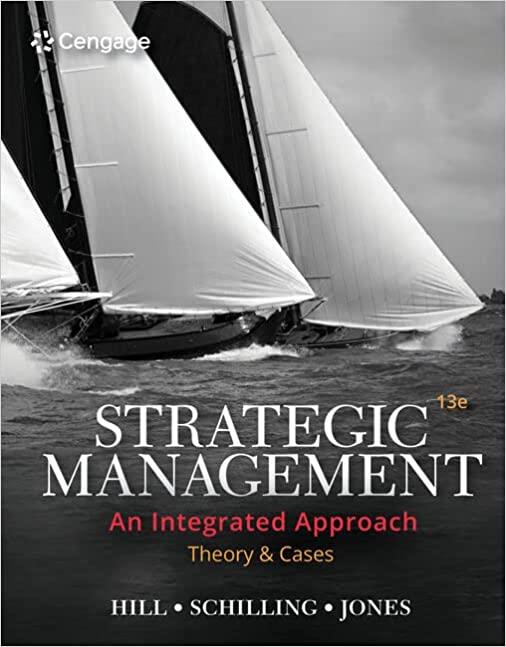Best Buy Co., Inc., is the worlds largest retailer of consumer electronics, computers, mobile phones, and related
Question:
Best Buy Co., Inc., is the world’s largest retailer of consumer electronics, computers, mobile phones, and related products. In the United States, it operates under the brands of Best Buy, Magnolia Audio Video, Pacific Sales, and Geek Squad. In Canada, it owns the chain of stores Future Shop; in China, it operates the Five Star stores. In 2014, Best Buy was one of the top twenty retail brands in America.
The rise of e-commerce had been hard on consumer electronics stores. Many notable rivals such as Circuit City and CompUSA did not survive the pressure online shopping put on prices and margins, and they liquidated their stores. In early 2015, even long-time electronics industry veteran Radio Shack announced it too would file bankruptcy and close its doors. Best Buy was the sole surviving multinational electronics retail chain.
Globally, the consumer electronics market was still experiencing a 5% compound annual growth rate between 2011 and 2015, for total sales of $1.01 trillion.
This growth was expected to continue through at least 2020 according to a study by Marketline.31 Most of that growth, however, was occurring in Asia’s growth economies where expanding middle classes were ramping up spending on electronics. In the United States, consumer electronics spending was flat. Making things tougher for Best Buy was the fact that an increasing percentage of consumers preferred to make electronics purchases online–
roughly 31% according to a February 2017 survey.32 The online sales channel was a difficult one in which to compete. There was intense pressure on prices, almost no customer loyalty, and big, generalpurpose competitors such as Amazon, Target, and Wal-Mart (see Table 6.1), along with large computer manufactures that sold in direct-to-customer channels.
Best Buy had been working hard to build its Web presence, and its online sales had growth to exceed $6 billion–roughly 20% of total sales–in 2017.
However, Best Buy was still primarily a bricks-andmortar retail chain that depended heavily on new product introductions in categories in which people wanted to physically compare products. When a new smartphone was introduced, for example, people often wanted to test it before committing to a purchase. Unfortunately for Best Buy, in many product categories people were increasingly relying on online reviews to make their purchase decisions.
They could browse among various vendors to find the best price. This led to extreme price competition that made it difficult for retailers with a strong physical presence to compete, because that physical presence typically resulted in a high-cost structure.
To combat online heavyweights like Amazon, Wal-Mart, and Target (and the growing threat from office-supply stores like Staples and Office Depot),

Best Buy implemented a price-matching policy: If customers found a better price online, Best Buy would match it. This put intense pressure on margins, so the company engaged in several cost-cutting measures, including shuttering many stores and cutting 40,000 jobs between 2010 and 2014. It also implemented a program whereby online purchases would be shipped directly from local stores, which helped to match Amazon’s speedy delivery times while simultaneously reducing inventory costs.
At the same time, Best Buy worked hard to differentiate its stores from the general-purpose competitors. Best Buy salespeople underwent extensive training to ensure that they could provide knowledgeable assistance to customers, and its Geek Squad service provided advanced technical support and home installation services. Best Buy also avoided paying commissions to individual salespeople in order to prevent the use of aggressive sales tactics.
To attract shoppers, Best Buy created programs that would make their stores a destination for consumers to experience electronics products in ways that were more complex or immersive. For example, in 2014, it created “Connected Home” sections in 400 stores, where customers could experience ways of automating their homes with products like programmable lights and thermostats, and home surveillance systems that would enable them to keep an eye on the family pet.
Customers found it difficult to shop for such products online; it was a product category that was still not well understood, and customers were often confused about the different components or features they might want to use. As described by Josh Will, senior vice president and general merchandise manager for cellphones, connected home products, and mobile stores, “We want to show them what’s possible. That’s very difficult to do in a digital-only environment.”
To survive, Best Buy would have to be both lean and differentiated. By 2018, it looked like its efforts were paying off. Though the company had suffered losses in 2012 and 2013, it posted over a billion dollars in profits in 2017, resulting in a 2.4% net profit margin. Though the company had taken a beating with the rise of online commerce, many analysts were betting that it would weather the storm, become a tougher competitor, and remain the winner in an increasingly difficult industry.
Questions
1. How does the ability to purchase online change consumer’s behaviors?
2. What kind of firm do you think will perform best in consumer electronics: a) physical bricks-and-mortar stores only, b) online only, c)
stores that have both physical and online presence? Why did you choose the answer you did?
3. How do you think online shopping changes the cost structure of retailers?
4. What would you recommend for Best Buy to do?
Step by Step Answer:

Strategic Management Theory And Cases An Integrated Approach
ISBN: 9780357033845
13th Edition
Authors: Charles W. L. Hill, Melissa A. Schilling, Gareth R. Jones





